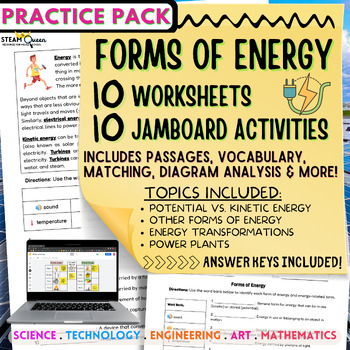Forms of Energy Practice: 10 Worksheets & 10 Jamboard Activities w/ Answer Keys
- Google Drive™ folder

Products in this Bundle (2)
Bonus
Also included in
- Transform Your Energy Unit with Our Comprehensive Bundle! Looking for a complete set of resources to enhance your energy unit, or need materials for sub plans, independent work, or extended absences? Our bundle has you covered! This 25+ piece bundle includes 10 visually-based worksheets with enoughPrice $15.00Original Price $17.50Save $2.50
Description
Save valuable time and effortlessly teach forms of energy, energy transformations, and power plants with our dynamic all-in-one resource bundle!
Experience the convenience and effectiveness as you dive into 10 student-friendly interactive Jamboard activities and learn with 10 engaging worksheets, complete with answer keys.
Get ready to elevate your lessons, support your students, and save time this school year with this unbeatable and user-friendly resource bundle!
Worksheet Features - Print & Go!
Perfect for small and whole group instruction - materials can also stand on their own as sub plans or independent work.
- Potential Energy - includes a brief informational passage about potential energy and different types of potential energy, as well as a vocabulary matching review w/word bank.
- Kinetic Energy - includes a brief informational passage about kinetic energy and different types of kinetic energy, as well as a vocabulary matching review w/word bank.
- Potential vs. Kinetic Energy - students sort different forms of energy as either potential or kinetic using a T-chart w/word bank; students describe the energy transformation occurring in water at the top of a dam/waterfall and after it has fallen.
- Forms of Energy (Pictures) - students classify images as different forms of energy.
- Forms of Energy (Vocabulary) - students read definitions for different forms of energy and energy-related terms and identify each term using a word bank.
- Energy Transformations (Cloze) - students complete statements about different energy transformations using a word bank.
- Energy Transformations (Scenario Analysis) - students choose an everyday scenario and summarize the energy transformations taking place, including recording the various forms of energy using a table.
- Energy Transformations (How Coal Was Formed) - students read an infographic about the formation of coal from the US Department of Energy, and identify the forms of energy involved in each step of the process using a table.
- Energy Sources (Wind & Coal) - students identify energy transformations in wind and coal power plants, and write a paragraph explaining the energy transformations taking place; is scaffolded to include suggested terms to use.
- Energy Sources (Solar & Hydropower) - students identify energy transformations in solar and hydropower plants, and write a paragraph explaining the energy transformations taking place; is scaffolded to include suggested terms to use.
Jamboad Activities - Perfect for Warm Ups!
The sequence of Jamboard activities can be assigned as a whole, broken up into individual frames as warm ups, or broken into bundles as follows:
Kinetic vs. Potential Energy
- Frame 1: General information about kinetic and potential energy.
- Frame 2: Students sort key vocabulary terms as falling under the kinetic side (ex: “in use”) or the potential side (ex: “height”).
Forms of Energy
- Frame 3: Students sort definitions for the 8 forms of energy, while also using a visual that helps them classify each of the 8 forms of energy as either kinetic or potential energy.
- Frame 4: Perfect for your visual learners, students classify images as representative of either kinetic or potential energy.
Energy Transformations
- Frames 5, 6, 7: Students identify multi-step energy transformations taking place in everyday scenarios.
Energy Transformations in Power Plants
- Frames 8 and 9: Students read the energy transformation steps in coal and hydropower plans to classify the forms of energy involved.
- Frames 10 and 11: Students expand on the previous two slides to compare, contrast, and evaluate coal power and hydropower plants.
Resources created with Universal Design for Learning in Mind
✧ Ideal for both classroom and virtual use.
✧ Check out our previews for a closer look!
➥ Energy Resources for Middle School:
- Energy Bundle - 25+ Pieces!
- Renewable Energy CER Pack
- Energy Unit Support Pack
- Thermal Energy Unit Support Pack
♛ Let's Connect!
- Visit The STEAM Queen Linktree
- Follow for Science & STEAM Resources






